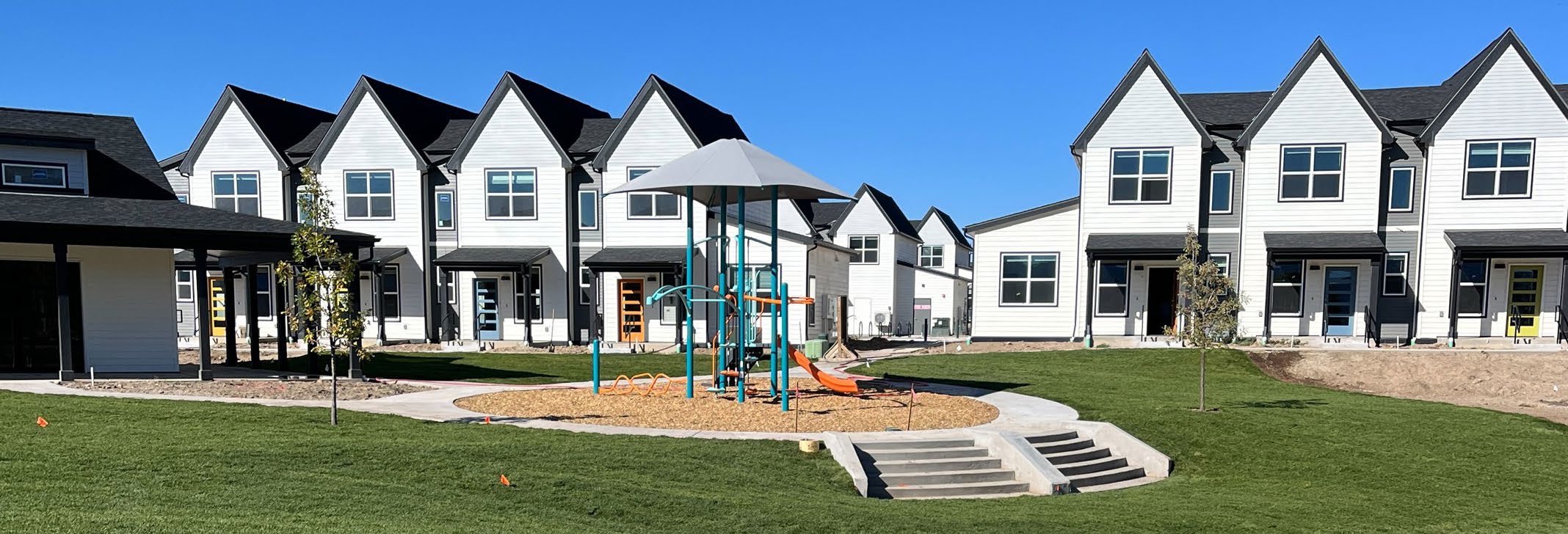Overview
Fruita Mews, undertaken by developer IndiBuild, is intended to help meet the need and desire for more affordable housing demonstrated in the 2021 Grand Valley Housing Needs Assessment as well as the City of Fruita’s 2020 Comprehensive Plan. At the outset of the project, the IndiBuild team conducted outreach and engagement activities with local government, schools, major employers, and more to help educate the community about affordable housing and to better understand their needs and perspectives. The result is an affordable community of 50 townhomes serving residents
|
Project Location |
Fruita |
|
IECC Climate Zone |
5 |
|
HTC Deal Type |
Federal 9 percent Housing Tax Credits |
|
Completed |
2024 |
|
Size (sf) |
48,431 |
|
Levels (#) |
2 |
|
Units (#) |
50 (9 one-bedroom, 31 two-bedroom, 11 three-bedroom) |
|
Buildings (#) |
11 |
|
Construction Type |
New construction |
|
Fuel Type |
All-electric |
|
Green Building Certifications |
National Green Building Standard – |
|
Total Development Cost |
$22,906,981 (2024) |
|
Operational Cost (PUPA) |
$5,230 |
Planning and Design Approach
It was important to the IndiBuild team that the Fruita community received high-quality affordable housing. As this is the first Housing Tax Credit development in Fruita, IndiBuild coordinated closely with the local government to support the establishment of a housing authority to partner with on the project.
Moreover, IndiBuild was guided by its values to provide housing that offers more than just shelter for residents, but the opportunity to be in community. The team designed the site to reflect the surrounding neighborhood.
Electrification Strategies and Features
|
Water Heating Individual electric resistance water heaters |
|
Space Heating and Cooling Split system, centrally ducted cold climate heat pump |
|
Ventilation Constant exhaust |
|
Cooking Electric resistance stoves |
The decision to build all-electric was a natural one for the IndiBuild team, who focuses on housing that is both “attainable and sustainable.” The project team chose to prioritize highly efficient design, evidenced by the decision to use a split system
Financing and Cost
The total development cost (TDC) of Fruita Mews was $22.9 million. The per unit per annum (PUPA) cost is $5,230 (2024). This is lower than the Mesa County average of $7,419 which includes older developments (CHFA Per Unit Per Annum (PUPA) Reporting).
When the IndiBuild team decided to design an all-electric property, the team chose to pursue funds through the High Efficiency Electric Heating and Appliances (HEEHA) grant program through the Colorado Energy Office. This program, which is no longer accepting applications, supported community efforts to switch to high efficiency electric heat and appliances. The IndiBuild team was awarded $1.39 Million in HEEHA funds to make the up-front investment in efficient, all-electric building systems for Fruita Mews. Notably, the team wanted to purchase electric clothes dryers using some of their HEEHA funds, but the bill that funded the program did not explicitly state that funds could be used for that purpose. The IndiBuild team successfully worked to support a bill amendment so they could use their funds to purchase the electric clothes dryers.
The team is also in the process of certifying to obtain 45L tax credits through their electrification efforts, a tax credit for eligible new or substantially reconstructed homes that meet applicable ENERGY STAR home program or DOE Zero Energy Ready Home (ZERH) program requirements. Fruita Mews is certifying to Energy Star.
Successes
Although Fruita Mews has only been operational for a short time, the project team has been successful in developing high-quality affordable housing. Additionally, the development of all-electric affordable housing outside of the Front Range can be considered a success in itself
The IndiBuild team reported successful community engagement and bridge-building throughout the development of Fruita Mews. The team reported that they worked with the area’s largest employers to create affirmative marketing programs, worked with state agencies and lawmakers to secure critical funding for the project, and engaged local organizations to provide resident services, all in service of addressing a critical need for affordable housing in Fruita.
Lessons Learned
The IndiBuild team had hoped to construct a community solar garden at Fruita Mews and offer discounts to residents through virtual net metering, but early in the design phase it became apparent that the electric cooperative serving the property did not have policies supportive of this arrangement. IndiBuild notes that it is important to discuss solar generation with your utility provider, especially in rural areas serviced by cooperatives, to understand restrictions early in the design phase. Although IndiBuild still hopes to develop a solar array at Fruita Mews, they decided not to proceed with one in the initial phase of development.
Importantly, the IndiBuild team noted that it was difficult to find contractors experienced with all-electric development for this project. They found that local contractors did not have as much experience with the requirements and reporting associated with some of the incentives used in all-electric projects, and largely hired subcontractors from across the Western Slope and Front Range for this reason. The team accepted the increased cost associated with the distance these subcontractors had to travel to work with them on Fruita Mews.
Project Team
|
Developer |
|
|
Architect |
|
|
General Contractor |
|
|
Structural Engineer |
|
|
Civil Engineer |
|
|
Mechanical, Electrical, and Plumbing (MEP) Engineer |
Integrated Mechanical; APS, Inc. |
|
Energy Engineer |
